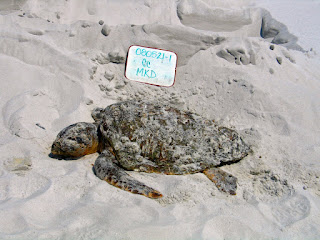
Today started out as planned, with an early wake-up (0445) to facilitate a day-long least tern survey in the Santa Rosa section of the Park. That lasted about an hour... The first detour was a simple matter of POD trouble -- and we've only had them a week. They're not exactly perfect construction.
The next detour was very welcome indeed! Jay Bonanno called from Perdido Key because he found a nest on the east end of the island. It was a very well-constructed, compact, nest for a loggerhead (Caretta caretta) with a distinct crawl, compared to the scratchy path from the Kemp's ridleys last week. It was a great training opportunity for our SCA, Sally. 
All the recent high west winds have created erosion bluffs on our beaches -- look at the drop this lovely lady took after laying her 133 egg nest. 
Since the egg chamber was only about 40 feet from the Gulf (it was on the seaward edge of this body pit), and the beach had already lost about three feet in the last week, we decided we had to move the nest.
First, we had to find a nice dune to move the eggs to. We try to move the eggs as little as possible, so we were happy to find a good dune about 100 feet north of the original nest. Then, I dug a new nest for the eggs to incubate in for the next two months. I use a cockle shell to help dig through the hard sand -- my skin is not as tough as a sea turtles!
Once I'd finished digging the nest, an upside down light bulb about 18 inches deep, it was time to gather the eggs from the original nest and place them gently in a cooler. 
We line the cooler with sand from the top of the nest, and carefully remove the eggs, one at a time, placing them in neat rows in the cooler. This helps us keep the eggs steady, and makes it easier to place the eggs back in the same place in the nest (i.e. so the top eggs are still the top eggs in the new nest).
We then carry the cooler to the new nest area, and place them gently in the nest egg chamber, one at time, in a honeycomb pattern so there's air space between the eggs, just as there are when the mother turtle lays them.
It was fun playing a mama turtle, but it was a lot of work. After searching for the eggs, building a new nest, relocating them one by one, packing sand back over them and camouflaging the area, my arms were sore! It's worth it to know the eggs are pretty safe from high tides and full moons. 
Our next detour was not so fun. Sally and I were headed back up the beach, checking on SNPLs as we did, when Mark called and asked for a contact at SRIA (Santa Rosa Island Authority). Eventually, he told me he needed them to move a large sea turtle stranding for us. I called them to arrange the transport (we have a 'sea turtle cemetery dune') and Sally and I headed for another training opportunity with the stranded animal. 
It's sad to see such a large, healthy, animal die needlessly. This particular loggerhead had swallowed two fishing hooks and a weight. It hadn't been dead long at all -- even the barnacles were still alive. Not a good way to end the day.
So the vehicle total for the day... At 5am, I drove my car to the park. I set up an ATV on a trailer and drove the blue truck to Santa Rosa. After the phone calls about nests and PODS, I drove Mark's white monster truck/fire engine to the Park, where I met Sally after her dawn Pensacola Beach turtle patrol. We piled into the red truck and I drove us to Perdido Key, where we took two ATVs to the turtle nest. We returned to the fire cache afterwards, changed from nesting gear to stranding gear, and returned to Pensacola Beach for the stranding in the red truck. Giant circles, lots of vehicles and LOTS of gas. I'm just happy I didn't have to pay for the fuel!
21 May 2008
One Nest, One Stranding, and How Many Vehicles?
Posted by
Turtle Girl
at
2:08 PM
![]()
![]()
Labels: caretta caretta, green sea turtle, Gulf of Mexico, loggerhead, nest, Perdido Key, sea turtle nest, stranding, turtle girl
Subscribe to:
Post Comments (Atom)
International Coastal Clean-Up!
The 2008 Coastal Clean-Up on Santa Rosa Island was a great success, but we can work together to make everyday a Coastal Clean-up Day... Help us keep our beaches beautiful!
For details on the 2009 coastal clean-up efforts in Pensacola or in your area, or other ways you can help, click here.
For details on the 2009 coastal clean-up efforts in Pensacola or in your area, or other ways you can help, click here.
Hello World!

Which way to the sea?









No comments:
Post a Comment